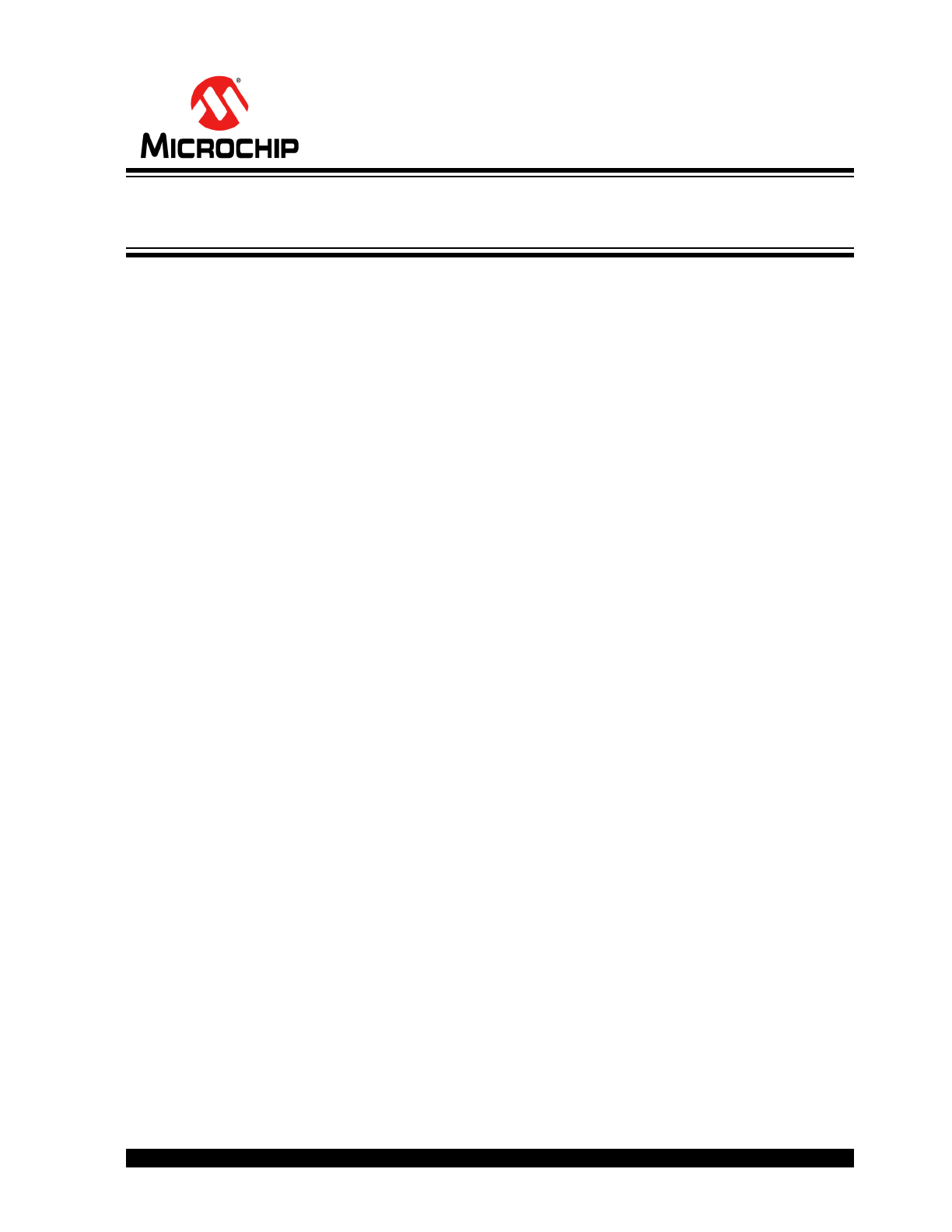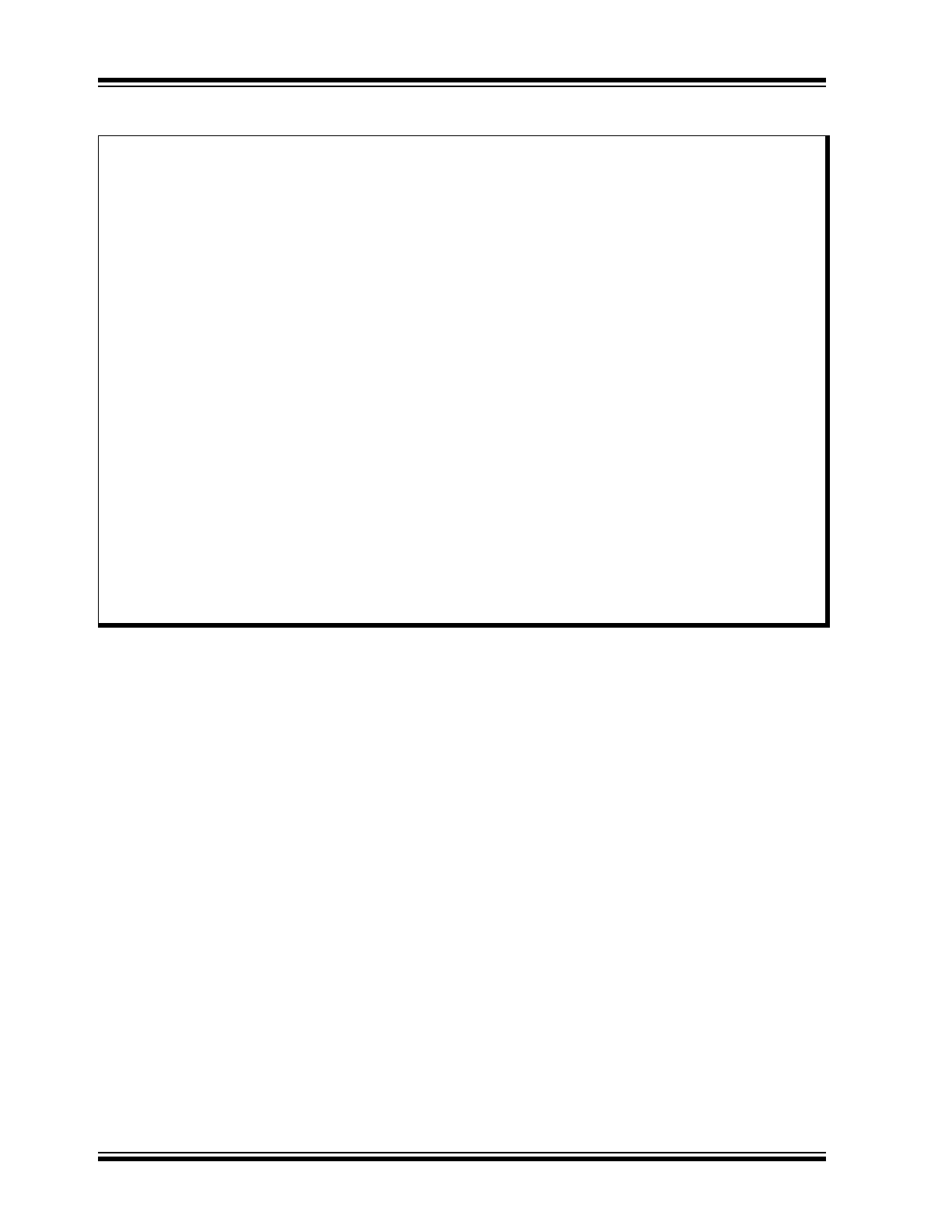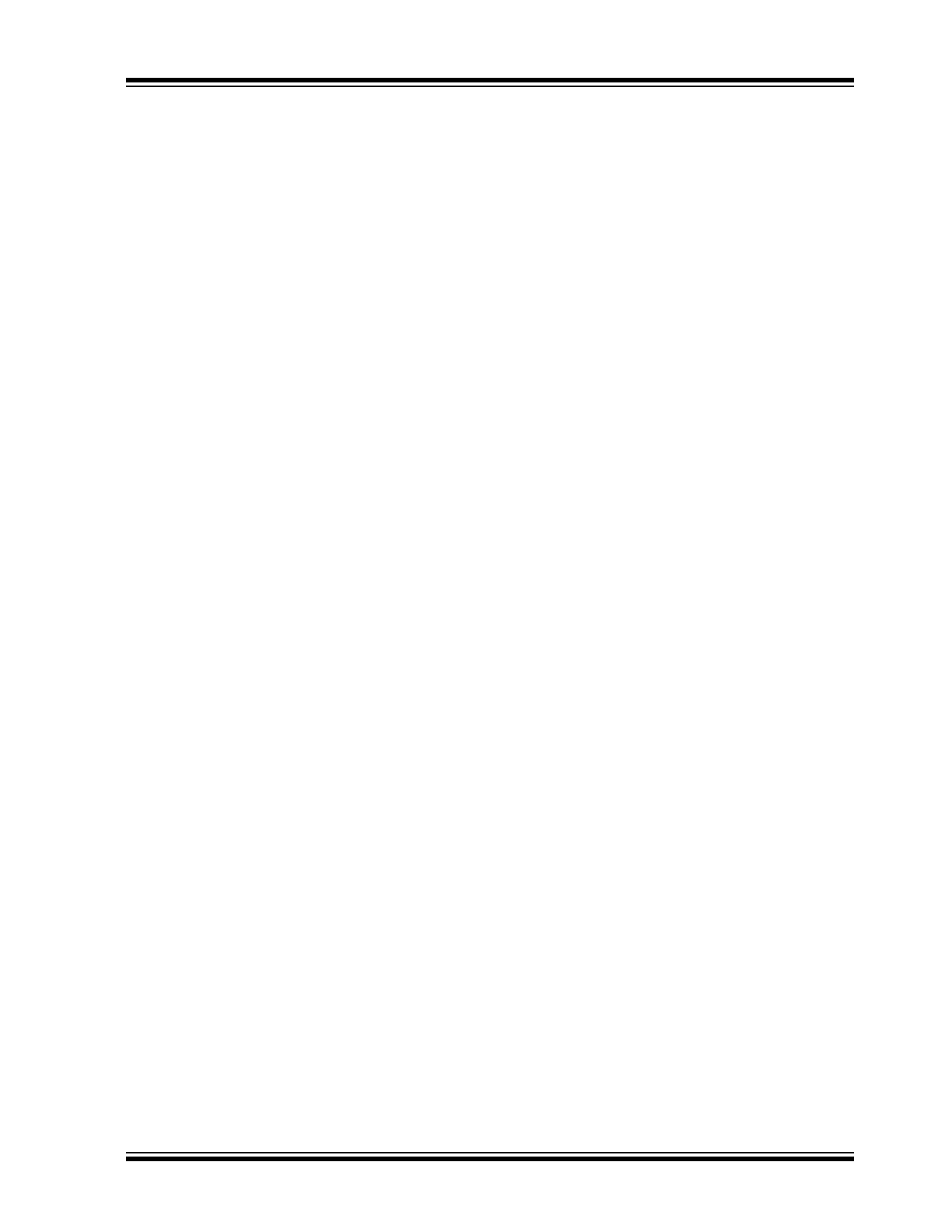
2014-2018 Microchip Technology Inc.
DS00001691C-page 1
Features
• Integrated USB 2.0 Compatible 3-Port Hub
• Advanced power saving features:
- 1
A Typical Standby Current
- Port goes into power saving state when no
devices are connected downstream
- Port is shut down when port is disabled
- Digital core shutdown in Bypass and Standby
Modes
• Provides USB Battery Charger Detection for:
- USB-IF Battery Charging 1.1 compliant Dedi-
cated Charging Ports (DCP)
- USB-IF Battery Charging 1.1 compliant
Charging Downstream Port (CDP)
- Standard Downstream Port (SDP); that is,
USB host or downstream hub port
- Downstream Hub Ports Support USB-IF Bat-
tery Charging 1.1 as Charging Downstream
Port (CDP)
• Supports either Single-TT or Multi-TT configura-
tions for Full-Speed and Low-Speed connections
(when connected to a High-Speed host)
• Bypass Switch for low power single port operation
- Battery charging detection using a PMIC
- Stereo and mono/mic audio
- USB1.1 Data
• Enhanced configuration options available through
serial I
2
C Slave Port
- VID/PID/DID
- String Descriptors
- Configuration options for Hub
• Internal Default configuration option when serial
I
2
C host is not available
• MultiTRAK
TM
- Dedicated Transaction Translator per port
• PortMap
- Configurable port mapping and disable
sequencing
• PortSwap
- Configurable differential intra-pair signal
swapping
• PHYBoost
- Programmable USB transceiver drive
strength for recovering signal integrity
• VariSense
TM
- Programmable USB receiver sensitivity
• flexPWR
®
Technology
- Low current design ideal for battery powered
applications
- Internal supply switching provides low power
modes
• External 12, 19.2, 26, or 38.4 MHz clock input
• Internal 3.3V & 1.2V Voltage Regulators for single
supply operation
- External VBAT and 1.8V dual supply input
option
• Internal Short Circuit protection of USB differential
signal pins
• ±5kV HBM ESD Protection
• 25-pin WLCS (1.95mm x 1.95mm Wafer Level
Chip Scale) Package - 0.4mm ball pitch
Target Applications
The USB3803 is targeted for applications where more
than one USB port is required. As mobile devices add
more features and the systems become more complex,
it is necessary to have more than one USB port to com-
municate with internal and peripheral devices.
• Mobile Phones
• Ultra Mobile PCs
• Tablet Computers
• Digital Still Cameras
• Digital Video Camcorders
• Gaming Consoles
• PDAs
• Portable Media Players
• GPS Personal Navigation Devices
• Media Players/Viewers
USB3803
USB 2.0 High-Speed Hub Controller Optimized
for Portable Applications

USB3803
DS00001691C-page 2
2014-2018 Microchip Technology Inc.
TO OUR VALUED CUSTOMERS
It is our intention to provide our valued customers with the best documentation possible to ensure successful use of your Microchip
products. To this end, we will continue to improve our publications to better suit your needs. Our publications will be refined and
enhanced as new volumes and updates are introduced.
If you have any questions or comments regarding this publication, please contact the Marketing Communications Department via
E-mail at
docerrors@microchip.com
. We welcome your feedback.
Most Current Data Sheet
To obtain the most up-to-date version of this data sheet, please register at our Worldwide Web site at:
http://www.microchip.com
You can determine the version of a data sheet by examining its literature number found on the bottom outside corner of any page.
The last character of the literature number is the version number, (e.g., DS30000000A is version A of document DS30000000).
Errata
An errata sheet, describing minor operational differences from the data sheet and recommended workarounds, may exist for cur-
rent devices. As device/documentation issues become known to us, we will publish an errata sheet. The errata will specify the
revision of silicon and revision of document to which it applies.
To determine if an errata sheet exists for a particular device, please check with one of the following:
• Microchip’s Worldwide Web site;
http://www.microchip.com
• Your local Microchip sales office (see last page)
When contacting a sales office, please specify which device, revision of silicon and data sheet (include -literature number) you are
using.
Customer Notification System
Register on our web site at
www.microchip.com
to receive the most current information on all of our products.

2014-2018 Microchip Technology Inc.
DS00001691C-page 3
USB3803
Table of Contents
1.0 General Description ........................................................................................................................................................................ 4
2.0 Acronyms and Definitions ............................................................................................................................................................... 7
3.0 USB3803 Pin Definitions ................................................................................................................................................................. 8
4.0 Modes of Operation ...................................................................................................................................................................... 15
5.0 Configuration Options ................................................................................................................................................................... 21
6.0 Serial Slave Interface .................................................................................................................................................................... 40
7.0 USB Descriptors ........................................................................................................................................................................... 44
8.0 Battery Charging ........................................................................................................................................................................... 63
9.0 Integrated Power Regulators ........................................................................................................................................................ 69
10.0 Specifications .............................................................................................................................................................................. 70
11.0 Application Reference ................................................................................................................................................................. 78
12.0 Package Outlines, Tape & Reel Drawings, Package Marking .................................................................................................... 82
Appendix A: Revision History .............................................................................................................................................................. 87
The Microchip Web Site ...................................................................................................................................................................... 88
Customer Change Notification Service ............................................................................................................................................... 88
Customer Support ............................................................................................................................................................................... 88
Product Identification System ............................................................................................................................................................. 89

USB3803
DS00001691C-page 4
2014-2018 Microchip Technology Inc.
1.0
GENERAL DESCRIPTION
The USB3803 is a family of low-power, USB 2.0 hub controllers with three downstream ports. “USB3803” is a generic
term referring to the entire family, which includes the following devices:
• USB3803C
• USB3803Ci
The USB3803 is available in two temperature ranges (commercial and industrial) and is recommended for new designs.
The USB3803 device includes an integrated USB bypass switch. This device-specific feature is called out independently
throughout the document.
Table 1-1
provides a summary of the feature differences between USB3803C and
USB3803Ci:
The USB3803 can attach to an upstream port as a full-speed hub or as a full-/hi-speed hub and supports low-speed,
full-speed, and hi-speed (if operating as a hi-speed hub) downstream devices on all of the enabled downstream ports.
The USB3803 has been specifically optimized for mobile embedded applications. The pin-count has been reduced by
optimizing the USB3803 for mobile battery-powered embedded systems where power consumption, small package
size, minimal BOM, and battery charger detection capabilities are critical design requirements. Standby mode and
Bypass mode power has been minimized. Instead of a dedicated crystal, reference clock inputs are aligned to mobile
applications. Flexible integrated power regulators ease integration into battery powered devices. Automatic battery
charger detection is available on the upstream port. All required resistors on the USB ports are integrated into the hub.
This includes all series termination resistors on D+ and D– pins and all required pull-down and pull-up resistors on D+
and D– pins.
The integrated USB switch allows the USB3803 to bypass the USB Hub and directly connect the upstream and Port 3
downstream USB port for operational modes that do not require Hi-Speed media transfers. The bypass switch enables
multiple connectivity options to the USB port while preserving the high speed signal quality in USB Hub Mode.
The USB3803 integrated battery charger detection circuitry supports USB-IF 1.1 charger detection methods. These cir-
cuits are used to detect the attachment and type of a USB Charger and provide an interrupt output to the portable device
indicating that charger information is available to be read from USB3803 status registers via the serial interface.
The USB3803 includes programmable features such as:
MultiTRAK
TM
Technology which utilizes a dedicated Transaction Translator (TT) per port to maintain consistent full-
speed data throughput regardless of the number of active downstream connections. MultiTRAK
TM
outperforms conven-
tional USB 2.0 hubs with a single TT in USB full-speed data transfers.
PortMap which provides flexible port mapping and disable sequences. The downstream ports of a USB3803 hub can
be reordered or disabled in any sequence to support multiple platform designs with minimum effort. For any port that is
disabled, the USB3803 hub controllers automatically reorder the remaining ports to match the USB host controller’s port
numbering scheme.
PortSwap which adds per-port programmability to USB differential-pair pin locations. PortSwap allows direct alignment
of USB signals (D+/D-) to connectors to avoid uneven trace length or crossing of the USB differential signals on the
PCB.
PHYBoost which provides programmable levels of Hi-Speed USB signal drive
strength in the upstream and downstream port transceivers. PHYBoost attempts to
restore USB signal integrity in a compromised system environment. The graphic on
the right shows an example of Hi-Speed USB eye diagrams before and after PHY-
Boost signal integrity restoration.
VariSense
TM
which controls the USB receiver sensitivity enabling programmable lev-
els of USB signal receive sensitivity. This capability allows operation in a sub-optimal system environment, such as
when a captive USB cable is used.
TABLE 1-1:
USB3803 FAMILY DIFFERENCES
Part Number
USB Bypass Switch
0°C to +70°C
-40°C to +85°C
USB3803C
X
X
USB3803Ci
X
X

2014-2018 Microchip Technology Inc.
DS00001691C-page 5
USB3803
1.1
Customer Selectable Features
A default configuration is available in the USB3803 following a reset. This configuration may be sufficient for most appli-
cations. The USB3803 hub may also be configured by an external microcontroller. When using the microcontroller inter-
face, the hub appears as an I
2
C slave device.
The USB3803 hub supports customer selectable features including:
• Optional customer configuration via I
2
C
• Compound devices on a port-by-port basis
• Customizable vendor ID, product ID, and device ID
• Configurable downstream port power-on time reported to the host
• Indication of the maximum current that the hub consumes from the USB upstream port
• Indication of the maximum current required for the hub controller
• Configurable as a Self-Powered and Bus-Powered Hub
• Custom string descriptors (up to 30 characters):
- Product string
- Manufacturer string
- Serial number string
• When available, I
2
C configurable options for default configuration may include:
- Downstream ports as non-removable ports
- Downstream ports as disabled ports
- USB signal drive strength
- USB receiver sensitivity
- USB differential pair pin location

USB3803
DS00001691C-page 6
2014-2018 Microchip Technology Inc.
1.1.1
BLOCK DIAGRAM
FIGURE 1-1:
USB3803 BLOCK DIAGRAM
B
y
pa
ss
Swi
tc
h
From PMIC/SOC
VDD33_BYP
Upstream
PHY
USB
Upstream
Repeater
Controller
SIE
Serial
Interface
PLL
REF_CLK
To I2C Master
Routing & Port Re-Ordering Logic
SCL
SDA
Port Controller
PHY#3
Bypass/
USB Data
Downstream
Mode
Control
-
Standby
Bypass
Hub Mode
VDD12_BYP
TT #3
TT #2
TT #1
PHY#2
PHY#1
USB Data
Downstream
USB Data
Downstream
1.2V Reg
RESET_N
BYPASS_N
VBAT
Upstream Battery
Charger Detection
HUB_CONNECT
3.3V Reg
VDD_CORE_REG
INT_N

2014-2018 Microchip Technology Inc.
DS00001691C-page 7
USB3803
2.0
ACRONYMS AND DEFINITIONS
2.1
Acronyms
EP:
Endpoint
FS:
Full-Speed
HS: Hi-Speed
I
2
C: Inter-Integrated Circuit
LS:
Low-Speed
2.2 Reference Documents
1.
USB Engineering Change Notice dated December 29th, 2004, UNICODE UTF-16LE For String Descriptors
2.
Universal Serial Bus Specification, Revision 2.0, Dated April 27th, 2000
3.
Battery Charging Specification, Revision 1.1, Release Candidate 10, Dated Sept. 22, 2008
4.
High-Speed Inter-Chip USB Electrical Specification, Version 1.0, Dated Sept. 23, 2007

USB3803
DS00001691C-page 8
2014-2018 Microchip Technology Inc.
3.0
USB3803 PIN DEFINITIONS
3.1
Pin Configuration
The illustration below shows the package diagram.
FIGURE 3-1:
USB3803 25-BALL PACKAGE
A
E
D
C
B
1
5
4
3
2
TOP VIEW

2014-2018 Microchip Technology Inc.
DS00001691C-page 9
USB3803
3.2
Signal Definitions
TABLE 3-1:
SIGNAL DEFINITIONS
WLCSP Pin
Name
Description
E2
USBUP_DP
Upstream D+ data pin of the USB Interface
E1
USBUP_DM
Upstream D- data pin of the USB Interface
A5
BYPASS_N
Control signal to select between HUB MODE and BYPASS MODE
C4
I2C_ASEL0
I
2
C Address Select Bit 0
B4
I2C_ASEL1
I
2
C Address Select Bit 1
A1
USBDN1_DP
USB downstream Port 1 D+ data pin
B1
USBDN1_DM
USB downstream Port 1 D- data pin
C2
USBDN2_DP
USB downstream Port 2 D+ data pin
D2
USBDN2_DM
USB downstream Port 2 D- data pin
C1
USBDN3_DP
USB downstream Port 3 D+ data pin
D1
USBDN3_DM
USB downstream Port 3 D- data pin
E5
SCL
I
2
C clock input
D5
SDA
I
2
C bi-directional data pin
E3
RESET_N
Active low reset signal
B5
HUB_CONNECT
Hub Connect
C5
INT_N
Active low interrupt signal
D4
REF_SEL1
Reference Clock Select 1 input
E4
REF_SEL0
Reference Clock Select 0 input
B3
REFCLK
Reference Clock input
A4
RBIAS
Bias Resistor pin
D3
VDD12_BYP
1.2V Regulator
A2
VDD33_BYP
3.3V Regulator
B2
VBAT
Voltage input from the battery supply
A3
VDD_CORE_REG
Power supply input to 1.2V regulator for digital logic core
C3
VSS
Ground

USB3803
DS00001691C-page 10
2014-2018 Microchip Technology Inc.
3.3
Pin Descriptions
This section provides a detailed description of each signal. The signals are arranged in functional groups according to
their associated interface.
The terms assertion and negation are used. This is done to avoid confusion when working with a mixture of “active low”
and “active high” signal. The term “assert” or “assertion” indicates that a signal is active, independent of whether that
level is represented by a high or low voltage. The term “negate” or “negation” indicates that a signal is inactive.
3.3.1
PIN DEFINITION
TABLE 3-2:
PIN DESCRIPTIONS
Name
Symbol
Type
Description
Upstream USB 2.0 / Bypass Interface
USB Bus Data
USBUP_DP
USBUP_DM
A-I/O
These pins connect to the upstream USB bus data
signals (Host port or upstream hub)
Bypass Select for Analog
Switch
BYPASS_N
I
Control signal to select between Hub Mode and
Bypass Mode. When asserted low, the device transi-
tions to Bypass Mode, connects the Bypass Port to
the upstream USB Port, places Port 1 and Port 2 in
high impedance state, and places the core logic in a
reduced power state. When negated high, the device
transitions to HUB MODE and enables operation as a
USB hub.
Downstream USB 2.0 / Bypass Interface
High-Speed USB Data
&
Port Disable Strap Option
USBDN_DP[2:1]
&
USBDN_DM[2:1]
A-I/O
These pins connect to the downstream USB periph-
eral devices attached to the hub’s ports
Downstream Port Disable Strap option:
This pin is sampled at RESET_N negation to deter-
mine if the port is disabled.
Both USB data pins for the corresponding port must
be tied to VDD33_BYP to disable the associated
downstream port.
HS USB Data
&
Bypass Port
USBDN_DP[3]
&
USBDN_DM[3]
A-I/O
When BYPASS_N is negated high, these pins con-
nect to the downstream USB peripheral devices
attached to the hub’s ports.
There is no downstream Port Disable Strap option on
these ports.
When BYPASS_N is asserted low, USBDN_DP[3]
and USBDN_DM[3] respectively are connected
through the analog switch to the upstream port
USBUP_DP and USBUP_DM. PortSwap setting has
no effect in Bypass Mode.
Serial Port Interface
Serial Data
SDA
I/OD
I
2
C Serial Data
Serial Clock
SCL
I
Serial Clock (SCL)

2014-2018 Microchip Technology Inc.
DS00001691C-page 1
Features
• Integrated USB 2.0 Compatible 3-Port Hub
• Advanced power saving features:
- 1
A Typical Standby Current
- Port goes into power saving state when no
devices are connected downstream
- Port is shut down when port is disabled
- Digital core shutdown in Bypass and Standby
Modes
• Provides USB Battery Charger Detection for:
- USB-IF Battery Charging 1.1 compliant Dedi-
cated Charging Ports (DCP)
- USB-IF Battery Charging 1.1 compliant
Charging Downstream Port (CDP)
- Standard Downstream Port (SDP); that is,
USB host or downstream hub port
- Downstream Hub Ports Support USB-IF Bat-
tery Charging 1.1 as Charging Downstream
Port (CDP)
• Supports either Single-TT or Multi-TT configura-
tions for Full-Speed and Low-Speed connections
(when connected to a High-Speed host)
• Bypass Switch for low power single port operation
- Battery charging detection using a PMIC
- Stereo and mono/mic audio
- USB1.1 Data
• Enhanced configuration options available through
serial I
2
C Slave Port
- VID/PID/DID
- String Descriptors
- Configuration options for Hub
• Internal Default configuration option when serial
I
2
C host is not available
• MultiTRAK
TM
- Dedicated Transaction Translator per port
• PortMap
- Configurable port mapping and disable
sequencing
• PortSwap
- Configurable differential intra-pair signal
swapping
• PHYBoost
- Programmable USB transceiver drive
strength for recovering signal integrity
• VariSense
TM
- Programmable USB receiver sensitivity
• flexPWR
®
Technology
- Low current design ideal for battery powered
applications
- Internal supply switching provides low power
modes
• External 12, 19.2, 26, or 38.4 MHz clock input
• Internal 3.3V & 1.2V Voltage Regulators for single
supply operation
- External VBAT and 1.8V dual supply input
option
• Internal Short Circuit protection of USB differential
signal pins
• ±5kV HBM ESD Protection
• 25-pin WLCS (1.95mm x 1.95mm Wafer Level
Chip Scale) Package - 0.4mm ball pitch
Target Applications
The USB3803 is targeted for applications where more
than one USB port is required. As mobile devices add
more features and the systems become more complex,
it is necessary to have more than one USB port to com-
municate with internal and peripheral devices.
• Mobile Phones
• Ultra Mobile PCs
• Tablet Computers
• Digital Still Cameras
• Digital Video Camcorders
• Gaming Consoles
• PDAs
• Portable Media Players
• GPS Personal Navigation Devices
• Media Players/Viewers
USB3803
USB 2.0 High-Speed Hub Controller Optimized
for Portable Applications

USB3803
DS00001691C-page 2
2014-2018 Microchip Technology Inc.
TO OUR VALUED CUSTOMERS
It is our intention to provide our valued customers with the best documentation possible to ensure successful use of your Microchip
products. To this end, we will continue to improve our publications to better suit your needs. Our publications will be refined and
enhanced as new volumes and updates are introduced.
If you have any questions or comments regarding this publication, please contact the Marketing Communications Department via
E-mail at
docerrors@microchip.com
. We welcome your feedback.
Most Current Data Sheet
To obtain the most up-to-date version of this data sheet, please register at our Worldwide Web site at:
http://www.microchip.com
You can determine the version of a data sheet by examining its literature number found on the bottom outside corner of any page.
The last character of the literature number is the version number, (e.g., DS30000000A is version A of document DS30000000).
Errata
An errata sheet, describing minor operational differences from the data sheet and recommended workarounds, may exist for cur-
rent devices. As device/documentation issues become known to us, we will publish an errata sheet. The errata will specify the
revision of silicon and revision of document to which it applies.
To determine if an errata sheet exists for a particular device, please check with one of the following:
• Microchip’s Worldwide Web site;
http://www.microchip.com
• Your local Microchip sales office (see last page)
When contacting a sales office, please specify which device, revision of silicon and data sheet (include -literature number) you are
using.
Customer Notification System
Register on our web site at
www.microchip.com
to receive the most current information on all of our products.

2014-2018 Microchip Technology Inc.
DS00001691C-page 3
USB3803
Table of Contents
1.0 General Description ........................................................................................................................................................................ 4
2.0 Acronyms and Definitions ............................................................................................................................................................... 7
3.0 USB3803 Pin Definitions ................................................................................................................................................................. 8
4.0 Modes of Operation ...................................................................................................................................................................... 15
5.0 Configuration Options ................................................................................................................................................................... 21
6.0 Serial Slave Interface .................................................................................................................................................................... 40
7.0 USB Descriptors ........................................................................................................................................................................... 44
8.0 Battery Charging ........................................................................................................................................................................... 63
9.0 Integrated Power Regulators ........................................................................................................................................................ 69
10.0 Specifications .............................................................................................................................................................................. 70
11.0 Application Reference ................................................................................................................................................................. 78
12.0 Package Outlines, Tape & Reel Drawings, Package Marking .................................................................................................... 82
Appendix A: Revision History .............................................................................................................................................................. 87
The Microchip Web Site ...................................................................................................................................................................... 88
Customer Change Notification Service ............................................................................................................................................... 88
Customer Support ............................................................................................................................................................................... 88
Product Identification System ............................................................................................................................................................. 89

USB3803
DS00001691C-page 4
2014-2018 Microchip Technology Inc.
1.0
GENERAL DESCRIPTION
The USB3803 is a family of low-power, USB 2.0 hub controllers with three downstream ports. “USB3803” is a generic
term referring to the entire family, which includes the following devices:
• USB3803C
• USB3803Ci
The USB3803 is available in two temperature ranges (commercial and industrial) and is recommended for new designs.
The USB3803 device includes an integrated USB bypass switch. This device-specific feature is called out independently
throughout the document.
Table 1-1
provides a summary of the feature differences between USB3803C and
USB3803Ci:
The USB3803 can attach to an upstream port as a full-speed hub or as a full-/hi-speed hub and supports low-speed,
full-speed, and hi-speed (if operating as a hi-speed hub) downstream devices on all of the enabled downstream ports.
The USB3803 has been specifically optimized for mobile embedded applications. The pin-count has been reduced by
optimizing the USB3803 for mobile battery-powered embedded systems where power consumption, small package
size, minimal BOM, and battery charger detection capabilities are critical design requirements. Standby mode and
Bypass mode power has been minimized. Instead of a dedicated crystal, reference clock inputs are aligned to mobile
applications. Flexible integrated power regulators ease integration into battery powered devices. Automatic battery
charger detection is available on the upstream port. All required resistors on the USB ports are integrated into the hub.
This includes all series termination resistors on D+ and D– pins and all required pull-down and pull-up resistors on D+
and D– pins.
The integrated USB switch allows the USB3803 to bypass the USB Hub and directly connect the upstream and Port 3
downstream USB port for operational modes that do not require Hi-Speed media transfers. The bypass switch enables
multiple connectivity options to the USB port while preserving the high speed signal quality in USB Hub Mode.
The USB3803 integrated battery charger detection circuitry supports USB-IF 1.1 charger detection methods. These cir-
cuits are used to detect the attachment and type of a USB Charger and provide an interrupt output to the portable device
indicating that charger information is available to be read from USB3803 status registers via the serial interface.
The USB3803 includes programmable features such as:
MultiTRAK
TM
Technology which utilizes a dedicated Transaction Translator (TT) per port to maintain consistent full-
speed data throughput regardless of the number of active downstream connections. MultiTRAK
TM
outperforms conven-
tional USB 2.0 hubs with a single TT in USB full-speed data transfers.
PortMap which provides flexible port mapping and disable sequences. The downstream ports of a USB3803 hub can
be reordered or disabled in any sequence to support multiple platform designs with minimum effort. For any port that is
disabled, the USB3803 hub controllers automatically reorder the remaining ports to match the USB host controller’s port
numbering scheme.
PortSwap which adds per-port programmability to USB differential-pair pin locations. PortSwap allows direct alignment
of USB signals (D+/D-) to connectors to avoid uneven trace length or crossing of the USB differential signals on the
PCB.
PHYBoost which provides programmable levels of Hi-Speed USB signal drive
strength in the upstream and downstream port transceivers. PHYBoost attempts to
restore USB signal integrity in a compromised system environment. The graphic on
the right shows an example of Hi-Speed USB eye diagrams before and after PHY-
Boost signal integrity restoration.
VariSense
TM
which controls the USB receiver sensitivity enabling programmable lev-
els of USB signal receive sensitivity. This capability allows operation in a sub-optimal system environment, such as
when a captive USB cable is used.
TABLE 1-1:
USB3803 FAMILY DIFFERENCES
Part Number
USB Bypass Switch
0°C to +70°C
-40°C to +85°C
USB3803C
X
X
USB3803Ci
X
X

2014-2018 Microchip Technology Inc.
DS00001691C-page 5
USB3803
1.1
Customer Selectable Features
A default configuration is available in the USB3803 following a reset. This configuration may be sufficient for most appli-
cations. The USB3803 hub may also be configured by an external microcontroller. When using the microcontroller inter-
face, the hub appears as an I
2
C slave device.
The USB3803 hub supports customer selectable features including:
• Optional customer configuration via I
2
C
• Compound devices on a port-by-port basis
• Customizable vendor ID, product ID, and device ID
• Configurable downstream port power-on time reported to the host
• Indication of the maximum current that the hub consumes from the USB upstream port
• Indication of the maximum current required for the hub controller
• Configurable as a Self-Powered and Bus-Powered Hub
• Custom string descriptors (up to 30 characters):
- Product string
- Manufacturer string
- Serial number string
• When available, I
2
C configurable options for default configuration may include:
- Downstream ports as non-removable ports
- Downstream ports as disabled ports
- USB signal drive strength
- USB receiver sensitivity
- USB differential pair pin location

USB3803
DS00001691C-page 6
2014-2018 Microchip Technology Inc.
1.1.1
BLOCK DIAGRAM
FIGURE 1-1:
USB3803 BLOCK DIAGRAM
B
y
pa
ss
Swi
tc
h
From PMIC/SOC
VDD33_BYP
Upstream
PHY
USB
Upstream
Repeater
Controller
SIE
Serial
Interface
PLL
REF_CLK
To I2C Master
Routing & Port Re-Ordering Logic
SCL
SDA
Port Controller
PHY#3
Bypass/
USB Data
Downstream
Mode
Control
-
Standby
Bypass
Hub Mode
VDD12_BYP
TT #3
TT #2
TT #1
PHY#2
PHY#1
USB Data
Downstream
USB Data
Downstream
1.2V Reg
RESET_N
BYPASS_N
VBAT
Upstream Battery
Charger Detection
HUB_CONNECT
3.3V Reg
VDD_CORE_REG
INT_N

2014-2018 Microchip Technology Inc.
DS00001691C-page 7
USB3803
2.0
ACRONYMS AND DEFINITIONS
2.1
Acronyms
EP:
Endpoint
FS:
Full-Speed
HS: Hi-Speed
I
2
C: Inter-Integrated Circuit
LS:
Low-Speed
2.2 Reference Documents
1.
USB Engineering Change Notice dated December 29th, 2004, UNICODE UTF-16LE For String Descriptors
2.
Universal Serial Bus Specification, Revision 2.0, Dated April 27th, 2000
3.
Battery Charging Specification, Revision 1.1, Release Candidate 10, Dated Sept. 22, 2008
4.
High-Speed Inter-Chip USB Electrical Specification, Version 1.0, Dated Sept. 23, 2007

USB3803
DS00001691C-page 8
2014-2018 Microchip Technology Inc.
3.0
USB3803 PIN DEFINITIONS
3.1
Pin Configuration
The illustration below shows the package diagram.
FIGURE 3-1:
USB3803 25-BALL PACKAGE
A
E
D
C
B
1
5
4
3
2
TOP VIEW

2014-2018 Microchip Technology Inc.
DS00001691C-page 9
USB3803
3.2
Signal Definitions
TABLE 3-1:
SIGNAL DEFINITIONS
WLCSP Pin
Name
Description
E2
USBUP_DP
Upstream D+ data pin of the USB Interface
E1
USBUP_DM
Upstream D- data pin of the USB Interface
A5
BYPASS_N
Control signal to select between HUB MODE and BYPASS MODE
C4
I2C_ASEL0
I
2
C Address Select Bit 0
B4
I2C_ASEL1
I
2
C Address Select Bit 1
A1
USBDN1_DP
USB downstream Port 1 D+ data pin
B1
USBDN1_DM
USB downstream Port 1 D- data pin
C2
USBDN2_DP
USB downstream Port 2 D+ data pin
D2
USBDN2_DM
USB downstream Port 2 D- data pin
C1
USBDN3_DP
USB downstream Port 3 D+ data pin
D1
USBDN3_DM
USB downstream Port 3 D- data pin
E5
SCL
I
2
C clock input
D5
SDA
I
2
C bi-directional data pin
E3
RESET_N
Active low reset signal
B5
HUB_CONNECT
Hub Connect
C5
INT_N
Active low interrupt signal
D4
REF_SEL1
Reference Clock Select 1 input
E4
REF_SEL0
Reference Clock Select 0 input
B3
REFCLK
Reference Clock input
A4
RBIAS
Bias Resistor pin
D3
VDD12_BYP
1.2V Regulator
A2
VDD33_BYP
3.3V Regulator
B2
VBAT
Voltage input from the battery supply
A3
VDD_CORE_REG
Power supply input to 1.2V regulator for digital logic core
C3
VSS
Ground

USB3803
DS00001691C-page 10
2014-2018 Microchip Technology Inc.
3.3
Pin Descriptions
This section provides a detailed description of each signal. The signals are arranged in functional groups according to
their associated interface.
The terms assertion and negation are used. This is done to avoid confusion when working with a mixture of “active low”
and “active high” signal. The term “assert” or “assertion” indicates that a signal is active, independent of whether that
level is represented by a high or low voltage. The term “negate” or “negation” indicates that a signal is inactive.
3.3.1
PIN DEFINITION
TABLE 3-2:
PIN DESCRIPTIONS
Name
Symbol
Type
Description
Upstream USB 2.0 / Bypass Interface
USB Bus Data
USBUP_DP
USBUP_DM
A-I/O
These pins connect to the upstream USB bus data
signals (Host port or upstream hub)
Bypass Select for Analog
Switch
BYPASS_N
I
Control signal to select between Hub Mode and
Bypass Mode. When asserted low, the device transi-
tions to Bypass Mode, connects the Bypass Port to
the upstream USB Port, places Port 1 and Port 2 in
high impedance state, and places the core logic in a
reduced power state. When negated high, the device
transitions to HUB MODE and enables operation as a
USB hub.
Downstream USB 2.0 / Bypass Interface
High-Speed USB Data
&
Port Disable Strap Option
USBDN_DP[2:1]
&
USBDN_DM[2:1]
A-I/O
These pins connect to the downstream USB periph-
eral devices attached to the hub’s ports
Downstream Port Disable Strap option:
This pin is sampled at RESET_N negation to deter-
mine if the port is disabled.
Both USB data pins for the corresponding port must
be tied to VDD33_BYP to disable the associated
downstream port.
HS USB Data
&
Bypass Port
USBDN_DP[3]
&
USBDN_DM[3]
A-I/O
When BYPASS_N is negated high, these pins con-
nect to the downstream USB peripheral devices
attached to the hub’s ports.
There is no downstream Port Disable Strap option on
these ports.
When BYPASS_N is asserted low, USBDN_DP[3]
and USBDN_DM[3] respectively are connected
through the analog switch to the upstream port
USBUP_DP and USBUP_DM. PortSwap setting has
no effect in Bypass Mode.
Serial Port Interface
Serial Data
SDA
I/OD
I
2
C Serial Data
Serial Clock
SCL
I
Serial Clock (SCL)
